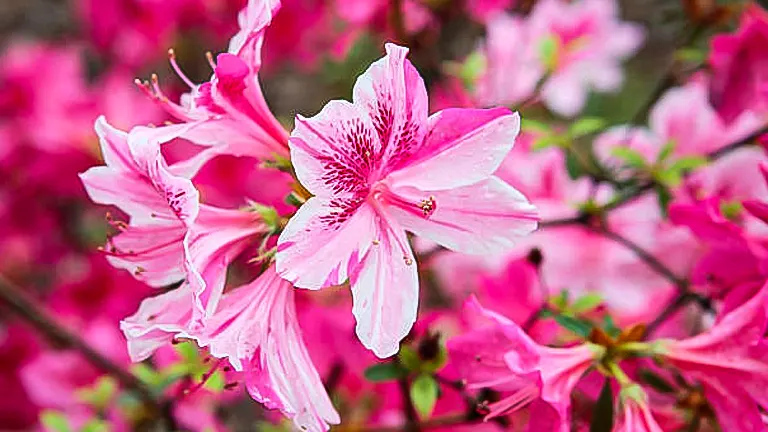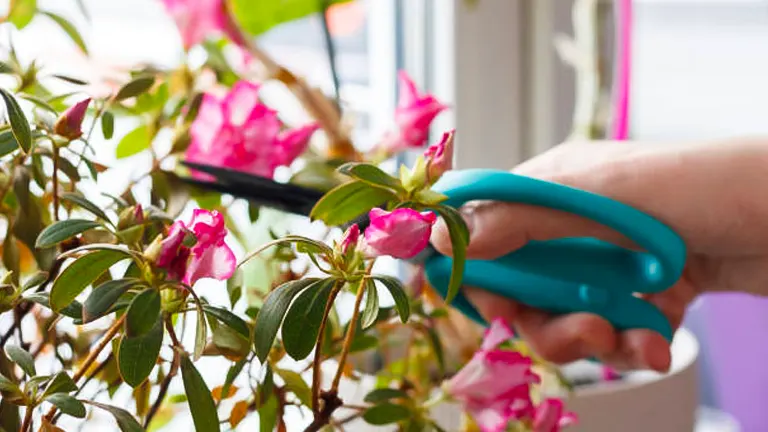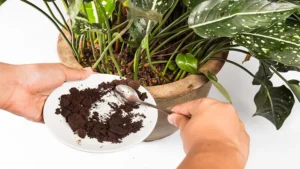How to Fertilize Azaleas: Unlock Blooming Success
- April 9, 2024
- 0 comment
Unlock the secret on how to fertilize azaleas! Learn the best fertilization practices and avoid common mistakes for lush, blooming success. Welcome to your comprehensive guide where we explore the delicate balance of nurturing these vibrant shrubs. With the right approach, azaleas transform into a stunning spectacle of color and life.

From selecting the perfect nutrients to mastering the timing of each application, we’ll navigate through every step to ensure your garden becomes a captivating display of floral excellence. Let’s embark on this journey together, turning challenges into opportunities for your azaleas to flourish.
Table of Contents
- Understanding Azaleas
- The Basics of Fertilizing Azaleas
- Planning and Planting for Success
- Step-by-Step Guide on How to Fertilize Azaleas
- Pruning Techniques for Azaleas
- Common Fertilization and Care Mistakes to Avoid
- Advanced Care Tips
- Conclusion
- FAQs
Understanding Azaleas

Azaleas, a captivating genus within the Rhododendron family, boast a diversity that encompasses over a thousand species, each with its unique charm and requirements. These plants are not just a feast for the eyes; they are a study in adaptability and resilience, thriving across a wide range of climates and conditions. To truly nurture azaleas, one must delve into the specifics of their needs, which are as varied and intricate as the species themselves.
Soil Requirements
The well-being of azaleas begins with the soil. These plants demand well-draining, acidic soil, with an ideal pH range of 4.5 to 6.0. This acidic environment is crucial for azaleas to access the nutrients essential for their growth, particularly iron, which is less available in alkaline conditions. Soil testing, a simple yet vital first step before planting, unveils the current pH level and nutrient profile, guiding the necessary amendments to create an optimal growing medium for your azaleas.
Seasonal Rhythms
Azaleas exhibit a pronounced growth cycle that is closely tied to the seasons. This cycle is not just a matter of aesthetics but a reflection of the plant’s physiological needs throughout the year. Key to this cycle is understanding the timing of:
- Fertilization: Best applied in early spring and again after blooming, to support the growth and development phases.
- Pruning: Ideally done soon after the bloom period, to shape the plant without sacrificing next year’s flowers.
- Watering: Adjusted according to the seasonal needs, more during dry spells in summer and reduced in the dormant winter phase.
Adapting your care regimen to these natural cycles is critical for sustaining the azaleas’ health and ensuring a spectacular display of blooms.
Unique Insights and Scientific Analysis
For those with a penchant for detail and a curiosity about the science underpinning azalea care, here are some fascinating numbers and facts:
| Parameter | Ideal Range/Value | Purpose/Effect |
|---|---|---|
| Soil pH | 4.5 to 6.0 | Facilitates nutrient uptake, especially iron, crucial for chlorophyll production and energy transfer. |
| Fertilizer N-P-K Ratio | 5-10-5 or similar | Balances growth (N), root development (P), and overall health and bloom (K). |
| Watering Depth | 10-12 inches | Encourages deep root systems, enhancing drought resistance. |
| Pruning Time | Post-bloom period | Ensures energy is directed towards new growth and bud formation. |
These parameters are more than just numbers; they are a testament to the intricate dance between azalea care and the environment, where each element plays a critical role in the plant’s lifecycle. Adjusting these factors to their ideal states supports not only the visible beauty of the azaleas but also their underlying health and vigor, paving the way for years of lush, vibrant blooms.
Understanding and catering to the complex needs of azaleas can be a rewarding endeavor, offering not just the joy of gardening but also a deeper appreciation of the natural world’s intricacies. Whether you’re a seasoned horticulturist or a curious novice, the world of azaleas offers endless opportunities for discovery and delight.
The Basics of Fertilizing Azaleas

Fertilizing azaleas is essential for their growth and vibrant blooms. The timing is crucial, with the best periods being early spring and after the blooming season. This schedule ensures azaleas get necessary nutrients at critical growth phases.
Choosing the Right Fertilizer
Selecting a suitable fertilizer is key. While a 15-15-15 N-P-K ratio (nitrogen, phosphorus, potassium) is a common recommendation, your azaleas’ specific conditions might require a different mix. Organic fertilizers are preferred for their gradual nutrient release and soil health benefits. Synthetic fertilizers work faster but should be used carefully to avoid problems like over-fertilization and root burn.
How to Apply Fertilizer
Applying fertilizer correctly is important. Spread it around the drip line, not close to the stem, to encourage healthy root spread. Water the area before and after applying fertilizer to help nutrients reach the roots effectively. Remember, using too much fertilizer can harm the soil and the azaleas.
Azalea Fertilization Guide Table
| Nutrient | Ideal Ratio | When to Apply | Benefits |
|---|---|---|---|
| Nitrogen (N) | Balanced or slightly higher | Early Spring & Post-Bloom | Promotes leaf growth and color. |
| Phosphorus (P) | Balanced | At planting & Early Spring | Aids root development and bloom quality. |
| Potassium (K) | Balanced | Early Spring & Post-Bloom | Boosts plant health and stress resistance. |
| Iron (Fe) | As needed | Early Spring | Needed for green leaves; prevents yellowing. |
Key Points
- Efficient Nutrient Use: Fertilizing at the right times helps azaleas use nutrients effectively, aligning with their natural growth and nutrient needs.
- Soil pH and Nutrient Absorption: Azaleas need acidic soil (pH 4.5-6.0) for best nutrient uptake. Soil pH affects how well azaleas can access certain nutrients.
- Avoiding Over-fertilization: Too much nitrogen can lead to salt build-up in the soil, causing problems like leaf burn and reduced water absorption.
Planning and Planting for Success

Successful azalea cultivation begins with thoughtful planning and precise planting. Understanding the spatial requirements, environmental factors, and soil conditions sets the foundation for thriving azalea plants.
Spatial Considerations for Optimal Growth
Azaleas’ spacing is not arbitrary; it’s based on their growth patterns and biological needs. Proper spacing ensures each plant receives adequate resources, such as light and air, crucial for reducing disease pressure and promoting healthy development.
- Individual Plant Spacing: Depending on the variety, azaleas should be spaced 2-5 feet apart. Dwarf varieties lean towards the lower end of this range, while larger species require more space.
- Row Spacing: For azalea rows or when planting in a more orchard-like setup, maintaining 5-6 feet between rows is essential. This distance supports maintenance activities and ensures plants receive sufficient sunlight.
Soil and Environmental Requirements
Azaleas flourish in specific soil and environmental conditions. Tailoring the planting site to meet these needs is key to their success.
- Soil Preparation: Incorporating organic matter into the soil improves its structure, moisture retention, and acidity. Aiming for a soil pH between 4.5 and 6.0 is ideal for azaleas, enhancing nutrient availability and uptake.
- Light and Shade Balance: Azaleas require a delicate balance of light and shade — morning sunlight with afternoon shade is optimal. This lighting condition prevents heat stress while ensuring enough light for healthy growth.
Azalea Planting Guide
| Factor | Specification | Purpose |
|---|---|---|
| Spacing (Individual) | 2-5 feet apart | Ensures proper air circulation and light exposure. |
| Row Spacing | 5-6 feet | Allows for maintenance and adequate sunlight. |
| Soil pH | 4.5-6.0 | Optimizes nutrient availability and uptake. |
| Soil Preparation | Enrich with organic matter | Improves soil structure, acidity, and moisture retention. |
| Light Requirements | Morning sun, afternoon shade | Balances light exposure to prevent stress and promote growth. |
Unique Insights for the Enthusiast
- Root Development and Spacing: Research indicates that azaleas’ root systems develop predominantly horizontally rather than vertically, emphasizing the importance of lateral spacing for nutrient and water absorption.
- Photosynthesis Efficiency: Azaleas adapted to partial shade have optimized their photosynthesis process to efficiently use the available light, making their placement critical for energy production.
- Soil Microbiome Support: Incorporating organic matter into the soil not only improves its physical characteristics but also supports a healthy soil microbiome. This microbial community plays a crucial role in nutrient cycling, further enhancing azalea health and bloom production.
By considering these advanced planning and planting strategies, gardeners can create an environment where azaleas not only survive but thrive. Attention to detail in the early stages of site selection and preparation can lead to a lush, vibrant garden filled with spectacular azalea blooms.
Step-by-Step Guide on How to Fertilize Azaleas
Step 1: Timing Your Fertilization
- When: The ideal time to fertilize azaleas is in early spring as new growth begins, and again after the flowering season ends to prepare for the next year’s growth. Avoid fertilizing late in the fall, as this can promote new growth that won’t withstand winter temperatures.
Step 2: Soil Testing
- Objective: Before applying any fertilizer, test your soil’s pH and nutrient content.
- How: Use a soil test kit available at garden centers or online. Azaleas thrive in acidic soil with a pH between 4.5 and 6.0.
- Why: Knowing your soil’s condition allows you to select the best fertilizer and understand if any pH adjustments are necessary.
Step 3: Selecting the Right Fertilizer
- Types of Fertilizers: Choose a fertilizer specifically designed for azaleas or acid-loving plants. These typically have a higher proportion of nitrogen.
- Organic vs. Synthetic: Consider using organic fertilizers for slow-release nutrients and soil health. Synthetic fertilizers offer quick nutrient release but must be used carefully to prevent over-fertilization.
Step 4: Calculating the Right Amount
- Guidance: Follow the instructions on the fertilizer packaging for the correct amount. Generally, azaleas require about 1 pound of actual nitrogen per 1,000 square feet per year.
- Adjustment: Adjust the quantity based on your soil test results and the size of your azalea garden.
Step 5: Proper Fertilizer Application
- Method: Apply fertilizer at the drip line of the azaleas, which is the outer edge of the plant’s canopy where it would naturally drip after a rain.
- Technique: Gently scratch the fertilizer into the top inch of soil and then water the area thoroughly. This helps the fertilizer penetrate the soil and prevents root burn.
Step 6: Watering After Fertilization
- Importance: Water your azaleas deeply immediately after applying fertilizer. This helps dissolve the fertilizer and carry it down to the roots of your plants.
- How Much: Ensure the water penetrates at least 6 inches into the soil to encourage deep root growth.
Step 7: Monitoring and Maintenance
- Observation: After fertilizing, keep an eye on your azaleas for signs of nutrient deficiency or excess (e.g., yellowing leaves for deficiency, leaf burn for excess).
- Adjustment: If your plants show signs of distress, consult a local extension service or a nursery for advice on adjustments.
Step 8: Mulching
- Purpose: Apply a 2-3 inch layer of organic mulch (like pine straw or shredded bark) around your azaleas after fertilizing. Mulch helps retain soil moisture, keeps roots cool, and gradually adds organic matter to the soil.
- How: Spread the mulch evenly around the base of the plants, avoiding direct contact with the stems to prevent rot.
Additional Tips
- Repeat Soil Testing: Conduct soil tests every 2-3 years to monitor changes in soil composition and pH.
- Seasonal Care: Be mindful of the specific needs of your azaleas throughout the seasons, adjusting water and care as necessary.
Pruning Techniques for Azaleas

Pruning is a pivotal part of azalea care, directly impacting their health, growth, and the vibrancy of their blooms. Understanding the when, why, and how of pruning can transform your azalea maintenance routine into a science-backed art form.
Optimal Pruning Times
- Post-Bloom Pruning: Timing is critical. Prune azaleas soon after their spring blooming cycle ends. This period is crucial because it’s before the azaleas set their buds for the next year, typically in early summer.
Detailed Pruning Strategies
- Selective Pruning
- Purpose: Removing dead or diseased branches is vital for plant health, preventing disease spread and pest infestation.
- Technique: Identify and cut back these branches to healthy wood, ensuring clean cuts that the plant can heal over smoothly.
- Thinning for Light and Air
- Goal: Improve light penetration and air circulation to reduce disease risk.
- Method: Selectively remove branches that crowd the plant’s interior or cross each other, focusing on opening up the plant’s structure.
- Shaping for Aesthetics and Health
- Approach: Encourage denser growth and desired shapes by pruning just above a leaf set or branching point, avoiding old wood unless specifically rejuvenating the plant.
- Rejuvenation Pruning
- When: For azaleas that are significantly overgrown or have sparse flowering.
- How: Drastically cut back the plant to 12-18 inches from the ground to stimulate vigorous new growth.
Pruning and Plant Physiology
Understanding the growth patterns and response mechanisms of azaleas to pruning offers fascinating insights into how these practices impact plant health and blooming.
- Bud Set Timing: Azaleas begin setting next year’s buds shortly after blooming, making early summer the deadline for pruning activities.
- Wound Healing: Azaleas have a remarkable ability to heal pruning wounds, especially when cuts are made at the correct angle and location, promoting healthy new growth.
Pruning Techniques and Benefits
| Technique | Description | Scientific Benefit |
|---|---|---|
| Selective Pruning | Removing dead/diseased branches. | Prevents disease spread and invigorates healthy plant sections. |
| Thinning | Cutting out crowded interior branches. | Enhances light penetration and air flow, reducing fungal risk. |
| Shaping | Trimming for desired form. | Encourages denser, healthier growth patterns. |
| Rejuvenation | Drastic reduction in plant size. | Stimulates new growth from the base, revitalizing old plants. |
Unique Insights for Enhanced Care
- Photosynthesis Optimization: Pruning can increase the efficiency of photosynthesis in remaining leaves by improving light exposure.
- Stress Reduction: Properly timed and executed pruning reduces stress on the azalea, allowing it to focus energy on healthy growth and bloom production.
Common Fertilization and Care Mistakes to Avoid

Proper care of azaleas goes beyond basic gardening practices; it’s about avoiding certain pitfalls that can undermine the health and beauty of these plants. Understanding and correcting these common mistakes can significantly improve your azalea gardening success.
Over-fertilizing: The Risk of Excess
- Impact: Excessive fertilizer can cause nutrient imbalances, leading to salt accumulation in the soil, which in turn may result in root damage or even plant death.
- Correction: Use a slow-release fertilizer specifically formulated for azaleas, and apply only the amount recommended on the label. If over-fertilization occurs, flush the soil around the plant with water to help dilute the concentration of fertilizer.
Choosing the Wrong Fertilizer
- Mistake: A fertilizer with an inappropriate N-P-K ratio or one that’s too strong can alter soil pH unfavorably and damage azalea roots.
- Solution: Select a fertilizer with a formulation designed for acid-loving plants. If the wrong fertilizer has been used, adjust the soil pH back to the optimal range using sulfur to lower it or lime to raise it, depending on the needs of your azaleas.
Improper Pruning Times
- Consequence: Pruning azaleas too late in the season can inadvertently cut off next year’s buds, drastically reducing flowering.
- Best Practice: Schedule pruning for just after the bloom cycle has concluded, typically in late spring or early summer, to avoid bud loss.
Ignoring Soil pH Requirements
- Issue: Azaleas thrive in acidic soil. A pH outside of their preferred range (4.5-6.0) can block nutrient absorption, affecting plant health and bloom vitality.
- Adjustment: Regularly test soil pH and use soil amendments such as elemental sulfur to decrease pH or garden lime to increase pH, as needed, to maintain the ideal acidity for azaleas.
Additional Common Mistakes
- Insufficient Watering: Azaleas require consistently moist soil. Allowing the soil to dry out completely can stress the plant, leading to leaf drop and failure to bloom.
- Remedy: Implement a regular watering schedule, adjusting based on weather conditions. Mulching can help retain soil moisture.
- Lack of Mulching: Not mulching or using an inappropriate mulching material can affect soil temperature and moisture levels adversely.
- Solution: Apply a 2-3 inch layer of organic mulch, such as pine straw or shredded bark, around the base of azaleas to help regulate soil conditions and protect roots.
Corrective Table for Azalea Care Mistakes
| Common Mistake | Impact | Corrective Action |
|---|---|---|
| Over-fertilizing | Salt build-up, root burn | Use slow-release fertilizers; if over-applied, flush soil with water. |
| Wrong Fertilizer Type | Altered soil pH, root damage | Choose acid-loving plant fertilizers; adjust soil pH as needed. |
| Improper Pruning | Loss of next year’s blooms | Prune immediately after blooming ends. |
| Neglecting Soil pH | Blocked nutrient absorption, poor growth | Regularly test and amend soil pH to stay within 4.5-6.0 range. |
| Insufficient Watering | Plant stress, leaf drop | Maintain consistent soil moisture; adjust watering as needed. |
| Lack of Mulching | Soil moisture evaporation, temperature extremes | Apply appropriate organic mulch to conserve moisture and protect roots. |
Advanced Care Tips
- Mulching for Moisture and Acidity: Azaleas thrive in moist, acidic soil. A layer of organic mulch, such as pine needles or shredded bark, can help maintain these conditions. Mulch retains soil moisture, suppresses weeds, and, as it decomposes, contributes to the soil’s acidity. Apply a 2-3 inch layer around your azaleas, keeping it away from the plant’s stem to prevent rot.
- Watering Wisely: While azaleas need moist soil, overwatering can be just as detrimental as drought. Water your azaleas deeply but infrequently, allowing the soil to dry slightly between waterings. This encourages deep root growth and prevents root rot, a common issue in poorly drained soils.
- Detecting and Correcting Nutrient Deficiencies: Yellowing leaves can indicate nutrient deficiencies, often a lack of iron or nitrogen—common in alkaline soils. Treating the soil with sulfur or iron sulfate can lower the pH, making these nutrients more available. However, before making any adjustments, it’s wise to perform a soil test to confirm the deficiency.
- Protection from Pests and Diseases: Regular monitoring can help catch issues like lace bugs or azalea gall early. Treat infestations with insecticidal soap or neem oil, and remove affected plant parts to control disease spread. Remember, healthy, well-cared-for azaleas are less susceptible to pests and diseases.
Related Post
- How to Fertilize a Mango Tree Effectively: Tips and Tricks for Healthy Growth
- How to Fertilize Apple Trees: Essential Tips for a Bountiful Harvest
- How to Fertilize Lemon Trees: Secrets for Thriving Citrus
- How to Fertilize Avocado Tree: A Step-by-Step Guide for Lush Growth
Conclusion
Azaleas, with their splendid blooms and lush foliage, are a garden’s pride. Achieving such beauty requires more than just planting and waiting; it demands a dedicated approach that includes proper fertilization, thoughtful spacing, timely pruning, and attentive care. By following the guidelines outlined in this guide, you can unlock the full potential of your azaleas, ensuring they become a vibrant highlight in your garden year after year.
FAQs
- What is the best time of year to fertilize azaleas?
The optimal times to fertilize azaleas are early spring before the bloom cycle begins and again after the flowers have faded. This schedule supports their growth phases and prepares them for a robust blooming season. - How can I tell if I’m over-fertilizing my azaleas?
Signs of over-fertilization include yellowing leaves, leaf burn at the tips and edges, slowed growth, and fewer blooms. If you notice these symptoms, hold off on further fertilization and water the plants deeply to help flush out excess nutrients. - Can I use coffee grounds as a fertilizer for my azaleas?
Yes, coffee grounds can be a beneficial addition to your azalea care routine. They add organic matter to the soil, improving drainage and aeration, and can help lower the soil pH, making it more acidic which azaleas prefer. - What should I do if my soil isn’t acidic enough for azaleas?
If your soil pH is too high (alkaline), you can lower it by applying sulfur or a soil acidifier formulated for acid-loving plants. Be sure to follow the product instructions carefully and retest your soil pH periodically to avoid over-acidifying. - How do I choose the right fertilizer for my azaleas?
Look for a fertilizer labeled for azaleas or acid-loving plants, ideally with a balanced N-P-K ratio or one slightly higher in nitrogen to encourage lush foliage. Organic options like cottonseed meal or fish emulsion are also excellent choices. - Is it necessary to water azaleas after fertilizing?
Yes, watering azaleas after fertilizing is crucial. It helps distribute the fertilizer evenly in the soil and prevents root burn by ensuring the nutrients are more diluted when they reach the plant roots. - How can mulching benefit my fertilization efforts?
Mulching helps retain soil moisture, keeps roots cool, and gradually adds organic matter to the soil as it decomposes, which can enhance nutrient availability. Just ensure the mulch is not piled against the plant stems to prevent rot. - Can pruning affect how my azaleas absorb fertilizer?
Proper pruning, done after the blooming season, can improve your azaleas’ overall health and vigor, making them more efficient at nutrient uptake. Removing dead or diseased branches and thinning out dense areas allow for better air circulation and light penetration, promoting a stronger, healthier plant that utilizes fertilizer more effectively.
This guide was designed to equip you with essential techniques for effectively fertilizing your azaleas, setting the stage for enhanced care and thriving plants. Here’s to cultivating a garden brimming with healthy, flourishing azaleas!

Benjamin Brooks
Forestry AuthorGreetings! I'm Benjamin Brooks, and my journey over the past 15 years has revolved around the fascinating realms of content creation, expertise in snow clearing, and the intricate world of lumberjacking and landscaping. What began as a simple curiosity about the natural world and heavy machinery has evolved into a passionate profession where my love for crafting words intertwines seamlessly with my lumberjacking and garden skills.













Leave your comment